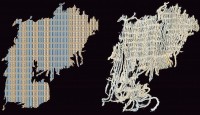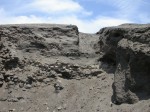 In 2009, archaeologists found textile fragments at the Preceramic settlement of Huaca Prieta in the Chicama Valley on the northern coast of Peru. The desert climate preserves organic materials and a great many early textiles made from wild cotton indigenous to the area have been unearthed there. What makes these fragments so significant is the dyed blue threads which are the oldest known indigo dyed textiles in the world, 1,800 years older than the Egyptian Fifth Dynasty textiles previously believed to be the oldest indigo dye.
In 2009, archaeologists found textile fragments at the Preceramic settlement of Huaca Prieta in the Chicama Valley on the northern coast of Peru. The desert climate preserves organic materials and a great many early textiles made from wild cotton indigenous to the area have been unearthed there. What makes these fragments so significant is the dyed blue threads which are the oldest known indigo dyed textiles in the world, 1,800 years older than the Egyptian Fifth Dynasty textiles previously believed to be the oldest indigo dye.
 Occupied between 14,500 and 4000, Huaca Prieta’s large ceremonial mound was first excavated in 1946 by archaeologist Junius Bird, curator of South American Archaeology at the American Museum of Natural History. There he unearthed the oldest known cotton textiles with recognizable figures — humans, birds, snakes — in the Americas. Those textiles are now in the American Museum of Natural History in New York.
Occupied between 14,500 and 4000, Huaca Prieta’s large ceremonial mound was first excavated in 1946 by archaeologist Junius Bird, curator of South American Archaeology at the American Museum of Natural History. There he unearthed the oldest known cotton textiles with recognizable figures — humans, birds, snakes — in the Americas. Those textiles are now in the American Museum of Natural History in New York.
 Bird’s trenches are still being excavated today and a number textile fragments are visible peering through the soil. It was in of those trenches, stratum 44 of trench HP-3, that archaeologists discovered two textiles with blue dye about 6200 to 6000 years old. The fragments are weft twining with warp stripes in different colors: the natural tan of the cotton, yarn woven with a white fiber from a local vine in the milkweed family and the blue. Chromatographic analysis of the textile confirmed the presence of an indigoid dye.
Bird’s trenches are still being excavated today and a number textile fragments are visible peering through the soil. It was in of those trenches, stratum 44 of trench HP-3, that archaeologists discovered two textiles with blue dye about 6200 to 6000 years old. The fragments are weft twining with warp stripes in different colors: the natural tan of the cotton, yarn woven with a white fiber from a local vine in the milkweed family and the blue. Chromatographic analysis of the textile confirmed the presence of an indigoid dye.
 Different plants can be used to make indigoid dyes. What they all have in common is indigotin, the main component in blue dye, and indirubin, an isomer of indigotin. There is no currently available test that can distinguish between the different genera of plants that are sources of indigo dye. Researchers believe the Huaca Prieta dye was derived from plants in the Indigofera genus which are native to South America and still used as dye plants today.
Different plants can be used to make indigoid dyes. What they all have in common is indigotin, the main component in blue dye, and indirubin, an isomer of indigotin. There is no currently available test that can distinguish between the different genera of plants that are sources of indigo dye. Researchers believe the Huaca Prieta dye was derived from plants in the Indigofera genus which are native to South America and still used as dye plants today.
Early examples of the use of blue yarns that were most likely colored with indigo are known, but dye analysis had heretofore been unavailable. The composition of the indigoid dyes identified in the fabrics presented here reflects that of earlier findings in Latin American and Asian contexts, in that proportions of indirubin relative to indigotin are significantly higher as compared to European productions. To date, there is no firm evidence to explain these differences, but plant species, harvesting, dye preparation, and actual dyeing, as well as differential conservation processes of essential dye components, may have, alone or in combination, contributed to this observation. One interesting hypothesis, requiring further confirmation, is that ancient vat dyeing technologies favored the formation and uptake by the yarn of indirubin. This would have resulted in a more purplish hue produced by a reddish indirubin and a bluish indigotin.
The textile fragments are now in the Cao Museum in Trujillo, Peru.